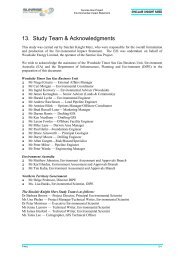Appendix D Terrestrial and Aquatic Biodiversity - Environment ...
Appendix D Terrestrial and Aquatic Biodiversity - Environment ...
Appendix D Terrestrial and Aquatic Biodiversity - Environment ...
Create successful ePaper yourself
Turn your PDF publications into a flip-book with our unique Google optimized e-Paper software.
SZ247: Bat survey from the Western Desert Resources Towns River project area, NT<br />
3.2 Acoustic detection<br />
The ultrasonic echolocation calls of bats, which are produced for spatial orientation <strong>and</strong> prey<br />
detection in flight, are useful for taxonomic identification because each species produces a<br />
unique <strong>and</strong> distinguishable (in many cases; see Milne 2002 for examples in the Northern<br />
Territory) signal type. Analysis of the recordings made using electronic 'bat detectors' can<br />
reveal echolocating bat diversity at sampling sites with minimal effort as part of a<br />
comprehensive approach to surveying bats. On the present survey, acoustic recordings<br />
were made with AnaBat SD1 bat detectors (Titley Scientific, Brisbane), which were chosen for<br />
their ease of use <strong>and</strong> deployment, <strong>and</strong> the efficiency of data storage; plus D500x full spectrum<br />
recorders (Pettersson Elektronik AB, Sweden) that retain amplitude information <strong>and</strong> features<br />
such as harmonic structure that can potentially be useful for species identification.<br />
AnaBat detectors were waterproofed in plastic boxes, <strong>and</strong> microphones (ST1) on an<br />
extension lead were placed in a funnel made from a plastic drink bottle to reduce the chance<br />
of water exposure. The use of funnels reduces slightly the zone of signal detection, but was<br />
unavoidable given the possibility of heavy rain. The D500x units were also placed in<br />
waterproof boxes with microphones on 1 m extension leads <strong>and</strong> protected by a PVC pipe<br />
(microphone was positioned flush with the edge of the pipe). The detectors were employed<br />
as passive stationary data recorders, being set in position prior to dusk <strong>and</strong> collected after<br />
dawn, <strong>and</strong> with the microphone capsule tied to trees at a height of c. 1 m. The equipment<br />
was placed in a variety of habitats to maximise the potential to encounter all species present.<br />
A GPS position was recorded at each recording site <strong>and</strong> associated with the serial number of<br />
the recording unit <strong>and</strong> deployment date.<br />
Echolocation signals from AnaBat detectors were divided by a factor of 8, <strong>and</strong> stored<br />
automatically on a Compact Flash card, with each sequence of calls receiving a time <strong>and</strong> date<br />
stamp. The sensitivity was set to around 7. The recording settings for the D500x were as<br />
follows: sampling frequency 300 kHz, Pre-trigger off, Recording length 1 sec, HP filter yes,<br />
Autorec yes, Trigger source 0, Trigger sensitivity 1 High, Input Gain 45, Trigger level 30,<br />
Interval 0, Timer 19:00 – 06:00.<br />
3.3 Analysis of acoustic recordings<br />
AnaBat recordings were downloaded using CFC Read ver. 4.3s software. The output<br />
consisted of two sets of data: 1. the individual sequence files produced during interpretation<br />
by CFC Read software, which are organised into folders representing a single night’s<br />
recording; <strong>and</strong> 2. the continuous representation of the AnaBat recordings in ZCA <strong>and</strong> MAP<br />
files, which show all of the signals detected by the AnaBat microphone but which have not<br />
been parsed into individual sequence files according to default interpretation parameters.<br />
The signals in both parsed sequence files <strong>and</strong> the ZCA <strong>and</strong> MAP files were examined in<br />
AnalookW ver. 3.8s software, <strong>and</strong> three parameters were measured on good quality search<br />
phase pulses in a subset of representative call sequences: pulse duration (milliseconds),<br />
maximum frequency (kHz) <strong>and</strong> characteristic frequency (the point at the end of the flattest<br />
portion of a pulse before any terminal secondary frequency sweep; kHz). A fourth variable<br />
was measured on Constant Frequency calls: the frequency with the greatest number of cycles<br />
Page 8 of 33



